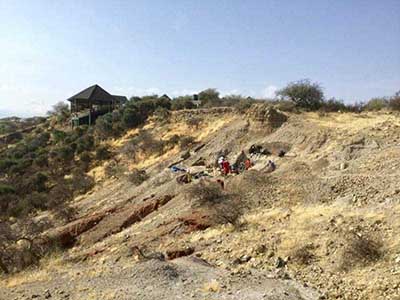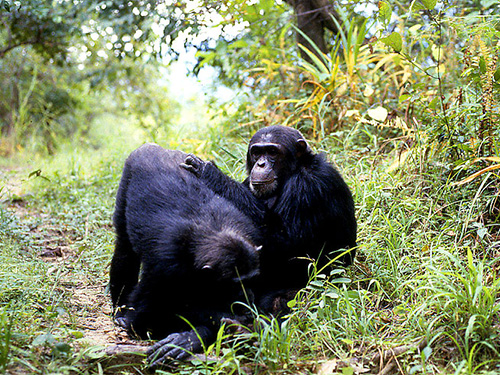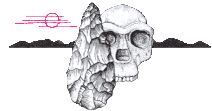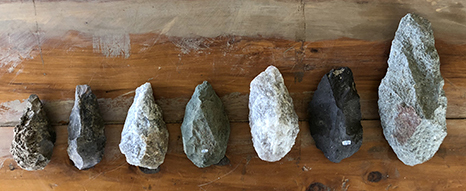
A selection of handaxes discovered at Olduvai Gorge.
Stone Age Institute
Laboratory and Experimental Research
Contents:
1. Experimental Manufacture and Use of Stone Tools
2. Brain Imaging Research
3. Stone Tool Behavior in Modern Apes
4. Archaeological Site Formation Research
5. Zooarchaeological Research into Bone Accumulation and Modification
6. Biomechanical Research
1. Experimental Manufacture and Use of Stone Tools
How were early stone tools made, and how could they have been used? Stone Age Institute researchers Nicholas Toth and Kathy Schick have devoted three decades of study to the experimental manufacture and use of stone tools. This is important research, as it takes archaeology out of the armchair and into direct investigation of the role tools have played in human evolution and adaptation. Such experimental studies can show us the possible techniques and strategies employed by prehistoric tool-makers. Importantly, they also reveal the types of tool-making debris associated with different manufacturing activities, so that we can identify these at archaeological sites. This gives us powerful means to interpret prehistoric artifactual materials from excavated sites, allowing us to understand tool-making techniques and abilities among prehistoric humans in the distant past.
Such experiments can give us important insights into early hominid tool-makers. They can provide valuable information about stages of manufacture represented at an archaeological site, levels of skill and expertise in early tool-makers, handedness in early human populations, use of different parts of sites for different activities, possible rules and conventions in making tools (and an early sense of ‘style’ and possibly even aesthetics in early stone tools), and decision-making in choosing raw materials for tools.
Experiments in using stone tools address essential functional and adaptive questions: why did early humans start making tools, and what role did these implements serve in their lives and adaptation? By using experimental stone tools for a range of activities, researchers can directly investigate which tools are best for which activities. They can also look for relationships between the form of an artifact and its function.
Stone Age Institute researchers Nicholas Toth and Kathy Schick have engaged in a variety of experimental studies of processing carcasses of animals that had died of natural causes. Such functional experiments can also help to identify other types of evidence that can indicate artifact use, such as edge damage and wear patterns on the edges of stone tools; fracture patterns; cut-marks, chop-marks, and hammerstone percussion and abrasion on animal bones; and organic residues on ancient stone tools. The identification of such prehistoric indicators of tool use is a high priority in Stone Age research.
Learn more about stone tool manufacture by watching Nick Toth's "Making Stone Tools" video which was produced by The Big History Project.

Above: An experimental handaxe manufactured by Nick Toth using a large
slab of quartzite from Naibor Soit, a quartzite source near Olduvai Gorge.
The handaxe is shown here with the flakes which resulted from its manufacture.
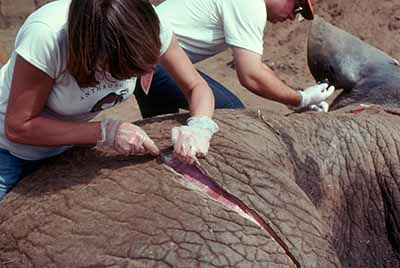
Above: Kathy Schick uses experimental stone tools to cut through
the hide of an elephant which died of natural causes.
2. Brain Imaging Research
What are the cognitive demands of making early stone tools? The manufacture and use of early stone tools represents a major evolutionary advance in the behavior of early hominids. Identifying any shifts in brain and cognitive function that may have been associated with this innovative behavior has long been priority in paleoanthropological research. Modern brain imaging techniques are now making it possible to address these questions directly.
The use of Positron Emission Tomography (PET) to examine patterns of brain activation during stone tool manufacture was pioneered in a pilot study of Oldowan tool-making by Stone Age Institute researchers Dietrich Stout, Nicholas Toth, and Kathy Schick, working with Julie Stout of the IU Psychology Department and Gary Hutchins of IU Radiology. This research was continued in a more systematic, multi-subject study by Dietrich Stout which revealed the unusual visual-spatial and motor demands of Oldowan tool-making and documented the changes in brain activation associated with skill acquisition. These results challenge accepted ideas about the psychological implications of the earliest stone tools and highlight those areas of the brain most likely to display evolutionary adaptations relevant to stone tool-making. More recently, Stout, Toth and Schick have completed a pilot study using PET to examine differences between Oldowan and later Acheulean stone tool-making, a project which will be expanded in the future.
In 2017, researchers Tom Schoenemann, Shelby Putt, Lana Ruck, Zara Anwarzai, and Chung-Lin Yang began using fMRI technology to research the evolutionary connection between stone toolmaking and language, a connection that has long been hypothesized by scientists. In order to further reveal aspects of this connection, the researchers conducted fMRI brain imaging while an expert stone toolmaker watched a video of himself making a stone tool. The preliminary results of the pilot study have revealed evidence for correlation of bilateral activation in Broca’s area during action perception of Acheulian stone tool technology. Broca's area is a region in the frontal lobe of the brain which has been linked to language processing and speech production since it was discovered and published by Paul Broca in 1865. This research is ongoing and will further our understanding of the evolution of human cognition.
To learn more about this research, watch the informative video of fMRI brain activity of the flintknapper watching himself create an Acheulian handaxe, or visit researcher Tom Schoenemann's Human Brain Evolution Lab website.
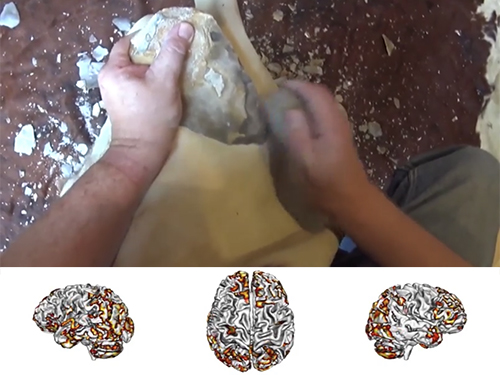
Above: fMRI images taken of Nick Toth's brain while he watches a video of himself
making a stone tool. This study was performed in order to investigate the role of
Broca's Area during stone toolmaking. This research may provide evidence that
stone tool manufacturing shares an evolutionary connection with language.
3. Stone Tool Behavior in Modern Apes
How skilled were early hominid tool-makers, and how do these skills compare to those among our closest living relatives, the apes?
Apes, especially chimpanzees in the wild, have a rich tool-using heritage that includes ant and termite fishing sticks, leaf sponges, and stone and wooden hammers and anvils for nut-cracking. Unfortunately, they do not intentionally flake stone in their natural settings.
Beginning in 1990, Stone Age Institute researchers Nicholas Toth and Kathy Schick, in collaboration with psychologists Sue Savage-Rumbaugh and Duane Rumbaugh at the Language Research Center in Atlanta, Georgia, have been working with African apes, especially bonobos or "pygmy chimpanzees," teaching them to make and use flaked stone tools.
Two bonobos in this study, Kanzi and his half-sister, Panbanisha, have acquired the basic skills to flake cobbles of lava, quartzite, and flint and to produce sharp-edged flakes and fragments to use for cutting activities to obtain food items. In 2005, the bonobos were moved to the Great Ape Trust in Des Moines, Iowa.
This research allows us to explore the cognitive and biomechanical skills and constraints of modern apes and helps us to assess levels of skill in early prehistoric human ancestors, and the transmission of these skills within a social group.
We have then been able to compare the tools made by modern apes to those made by early hominids and modern tool-makers, and compare and contrast the amount of finesse and skill shown by the ancient and modern species.
Here is a video of Kanzi making and using a stone tool.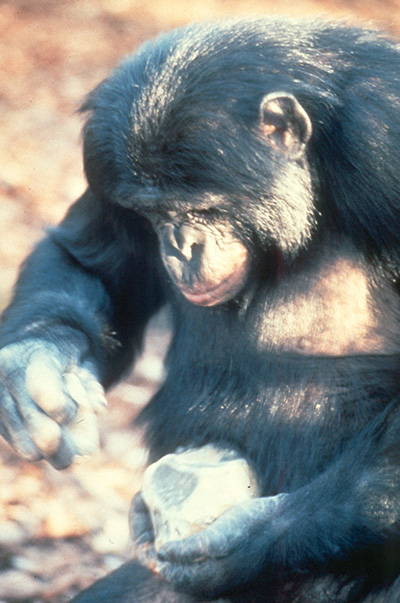
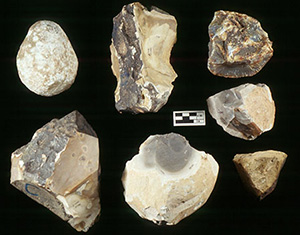
Left: Kanzi flaking stone. Right: Stone artifacts modified by Kanzi during stone tool experiments.

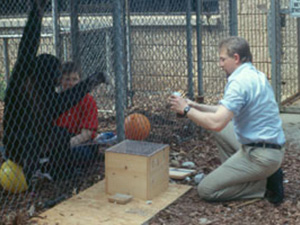
Left: The Bonobo Panbanisha holding a photograph of swans.
Right: Kanzi watches as Nick Toth demonstrates flaking stone.
4. Archaeological Site Formation Research
How do archaeological sites form, and what do patterns at our sites reveal about prehistoric behavior patterns? How archaeological sites form – what patterns are created by hominid tool-making and tool-using activities, and how do these get buried and preserved to form our archaeological record – has become a major concern for paleoanthropological researchers. It has become apparent that we must understand this process of site formation in order to interpret the sites that we excavate.
Research by Stone Age Institute researcher Kathy Schick has actively investigated the dynamics of site formation, helping us identify sites showing good preservation of ancient prehistoric behaviors. This research has included setting out experimental sites along rivers, deltas, and lake margins, and monitoring the changes that occur over the course of time during flooding and burial. Such studies have given us powerful criteria to help us identify the behavioral information contained in early archaeological sites.
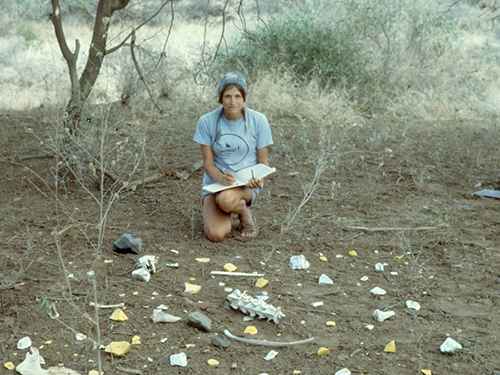
Above: Kathy Schick creates and monitors a controlled experiment in site formation.
5. Zooarchaeological Research into Bone Accumulation and Modification
How do animal remains become buried and preserved in the fossil record, and what do fossil animal bones at archaeological sites tell us about early hominid behaviors? Fossil animal bones have a persistent presence at early Stone Age archaeological sites, but it has not always been clear what agencies were responsible for collecting and modifying these remains. Were early hominids hunters or scavengers? Did they collect and process animal remains at archaeological sites, or were other animals, such as hyenas or large cats, the principal agents of accumulation and modification? These are important questions to resolve in order to understand early hominid behavior and adaptation, and they demand a profound understanding of how humans and other agents collect and modify bones.
Stone Age Institute researchers Michael Pante, Travis Pickering, Jason Heaton, Charles Egeland, Nicholas Toth, and Kathy Schick have pursued these questions in a multitude of ways, including the analysis of animal bones from prehistoric sites, as well as actualistic and experimental studies of the effects of human and carnivore agents on bone assemblages. Examples of such studies include ethnoarchaeological research, experiments processing animals (that had died of natural causes) with stone tools, analysis of bone accumulations made by modern hyenas, and in-depth analyses of tooth-marks and cut-marks as well as bone fracture patterns.
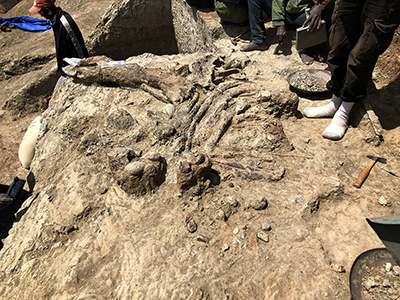
Above: The nearly one million-year-old fossilized remains of an elephant are revealed,
along with associated stone tools, during an excavation at Olduvai Gorge.
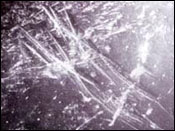

Left: A scanning electron microscope image of stone tool cutmarks on a one million year old fossil bone.
Right: Nicholas Toth surveys materials found near an abandoned hyena den in Jordan.
6. Biomechanical Research
How have our bodies changed and adapted to our tool-making in the course of human evolution? The configuration of our bones and muscles determines what motions and actions we can perform well and efficiently, and these have changed in human evolution as the human body has evolved into its modern form. The modern human hand, arm, and shoulder are product of at least 2.5 million years of evolutionary selection for tool behavior. To appreciate these changes, it is important to examine the actual biomechnical patterns involved in efficient stone tool-making.
A pilot study by Stone Age Institute affiliate and kinesiologist, Jesus Dapena, and Nicholas Toth examined the biomechanics of manufacturing Oldowan artifacts. Stone Age Institute graduate researcher, Leslie Harlacker, is currently conducting a comprehensive study comparing the biomechanical patterns of tool-making among human novices to those observed in experienced stone knappers, and also comparing the patterns of humans to tool-making apes, as part of her Ph.D. dissertation research.
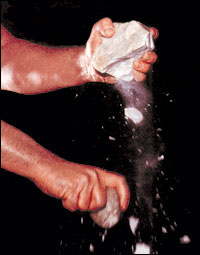
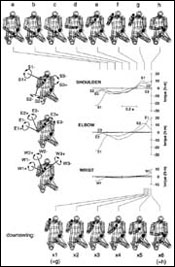
Left: A photograph illustrates events the moment after a stone is struck with a hammerstone.
Right: A diagram illustrating the biomechanics of Oldowan flaking.

